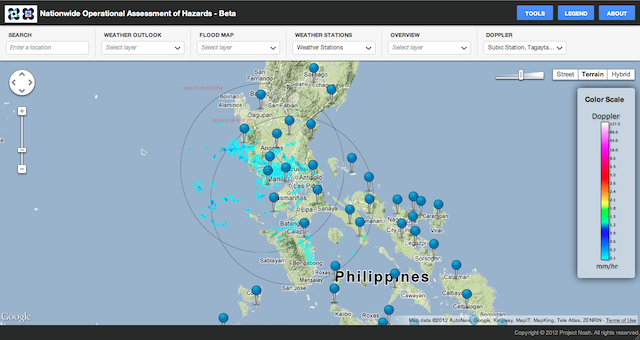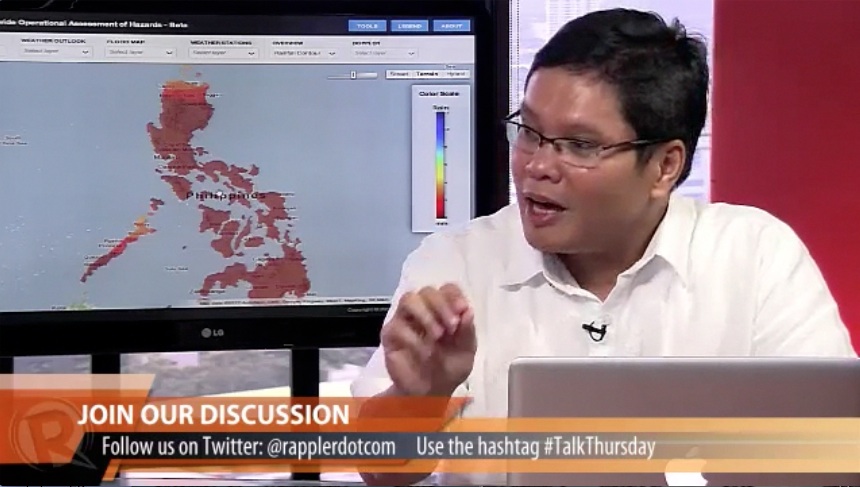SUMMARY
This is AI generated summarization, which may have errors. For context, always refer to the full article.

MANILA, Philippines – As heavy rain poured over most of Metro Manila on Sunday evening, people living along the banks of Marikina River, still scarred by their experience during tropical storm “Ondoy,” wondered if it was going to be another sleepless night.
To know what lay ahead, the local government and other concerned groups turned to a 2-month-old website: the Nationwide Operational Assessment of Hazards, or NOAH.
The NOAH is the government’s newest project designed to help address the perennial problems brought by ill-informed decision in the face of disasters, some sort of modern-day Noah’s Ark that aims to help save people and property from the ravages of natural disasters.
Dr Alfredo Mahar Lagmay, executive director of the NOAH project, told Rappler on Thursday, June 28, that the project was the result of collaboration among various government agencies and private groups.
“The President instructed the Department of Science and Technology (DOST) to put in place a responsive program to address our problems with disasters,” Lagmay said on Rappler’s #TalkThursday show.
Project NOAH has seven major components designed to address major needs in disaster situations, the DOST said. These include projects in hydrometeorology, flood monitoring, landslide monitoring, weather forecasting, and storm surge inundation mapping.
Accurate, reliable information
Its most visible component is the NOAH website on http://noah.dost.gov.ph. Lagmay said the site seeks to show an overview of the project’s many aspects, from weather to floods.
Currently it delivers the latest information about weather-related disasters with the help of state weather bureau PAGASA. Soon, it will also deliver information about other hazards, such as earthquakes, landslides, storm surges, and tsunamis, he said.
“NOAH basically wants to deliver accurate, reliable, and timely information that’s to empower communities,” he said.
Soon, sensors from all parts of the country will send information on rainfall, temperature, water levels, and other relevant data to the website, giving an overview of conditions from the national up to the local level.
But NOAH isn’t just useful for disasters. For everyday activities, people can turn to the website to determine if it will rain in their area, without waiting for the latest PAGASA bulletin.
It is also a tool that can be used for development planning. Lagmay said they are slowly working to change people’s mindsets about disasters.
Filipinos currently treat disasters as one-off events; but in reality, he said, disasters are results of failing to plan ahead. The project aims to give local governments, companies, and individuals informationto help them plan ahead and lessen damage and casualties from disasters.
Everyone involved
Project NOAH will also allow local governments, the private sector, and most especially citizens to participate in disaster risk reduction and management efforts.
“We need everyone to participate – we need the private sector, we need the civil society organizations, we need the media, we need the government institutions, we need the communities, we need the LGUs, we need the individuals to participate,” Lagmay said.
The project brings together experts from 21 institutions, both from the public and private sector, including PAGASA, the Philippine Institute of Volcanology and Seismology, several universities, and even media and the 3 major telecommunication companies.

The project also has information dissemination and education components to help people understand the various uses of the project.
They are starting an extensive information campaign, first for the website, then for the program in general, starting with the “Talakayan” disaster caravan in cooperation with the Department of the Interior and Local Government (DILG).
To educate more people, they will also have instructional videos through DOST, and plans to integrate use of the maps among communities.
They will also have different methods of information dissemination, including SMS, internet, social media, and broadcast media. They are also eyeing technologies such as “super WiFi,” which utilizes unused broadcast wavelengths to spread information.
Culture of safety
The project is only 2 months old, and the timeline for full implementation runs until 2013, but it is slowly catching the attention of netizens, local governments, and private groups.
In the case of Marikina, Lagmay said the people in charge of disaster response in the city turned to the NOAH website to check rainfall and water levels in the Marikina River.
That night, they were able to monitor water levels at the Montalban station rising to “critical” levels between 5pm to 9pm. People at the city hall closely monitored the situation, fearing a repeat of the events of October 2009. And because of additional information about weather, rainfall probability, and cloud movements, they saw that the rain would stop soon.
On Monday morning, the disaster officials saw clouds moving away, and water levels going back to normal.
“So rather than sounding off the alarm to evacuate, they had a handle of the situation, have access to real-time information, and that information was used in their decision-making process,” he said.
Hopefully, Project NOAH will help Filipinos lead a culture of safety, with people more conscious about disasters and how to confront and address the challenges we face. This change in mindset is a crucial factor for the project to be successful, the geologist and disaster expert said.
“It should be an effort that should be participated in by everybody, not just by the government, because no government agency or group of agencies can handle the disaster problems that we face,” Lagmay said.
“That’s the only way by which a good and effective disaster management and mitigation program would work,” he added.
“No matter what the government says and does, when the people don’t listen and don’t do their responsibility, then all efforts of government, including NOAH, will be in vain,” said Lagmay. – Rappler.com
Elsewhere in Rappler:
Add a comment
How does this make you feel?
There are no comments yet. Add your comment to start the conversation.